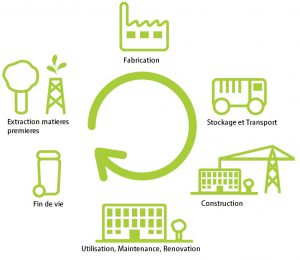The city is a mix of buildings renovated, old, new, already shaved or to be built. At any given time will always question, is it better, shaved and rebuild, or build on a vacant? The analysis of Cycle of life (ACV) provides part of the answer in terms of environmental impact.
LCA quantifies the environmental impacts of any product generally, extraction of contents to the elimination of its waste, according to different criteria such as the CO2 emissions or waste (detailed in the ISO 14040 standard definition). Applied to the neighborhoods, it allows to measure the impact of urban or architectural choices on the environment during the four phases of the life cycle of the District:
- construction (extraction of raw materials, production and transport of materials),
- use (heating, lighting, water consumption, etc.).
- renovation (replacement of components: windows, insulation, coverings of buildings and streets).
- and demolition (transport and waste treatment).

Life cycle of a building – source: inspired by hqe
Note that the environmental performance of a neighbourhood is not simply the sum of the balance sheets of the various buildings that make it up. Indeed, it must take into account the interactions between buildings, whether at the level of the solar masks, energy systems shared etc. We must also consider the relationship between the neighborhood and the rest of the city, or even the region, either regarding media (performance of the water supply network, potential heat network, drinking water and wastewater, etc.), transport (roads, trails, transportation systems, etc.), waste management (landfill, incinerator, recycling plants, energy recovery potential, etc.) , climate, different sources of electricity generation, heat, local supply chains in fuel like wood, (bio) – gas etc.
Data features in the area necessary for the realization of his ACV can be largely extracted and stored in the 3D city models: date of construction/renovation/demolition, use of buildings, geometry and materials of construction etc. These data will be generally crossed to typologies of buildings as well as databases of materials and processes (ecoinvent etc.).
Prerequisite: Model of 3D city (LoD2 or more), construction, renovation, given data macros at the level of the region (energy mix, etc. supply chains)
Initiatives & contacts
ZAC Claude Bernard in Paris
- http://www.erudit.org/Revue/eue/2011/V5/n/1007605ar.PDF
